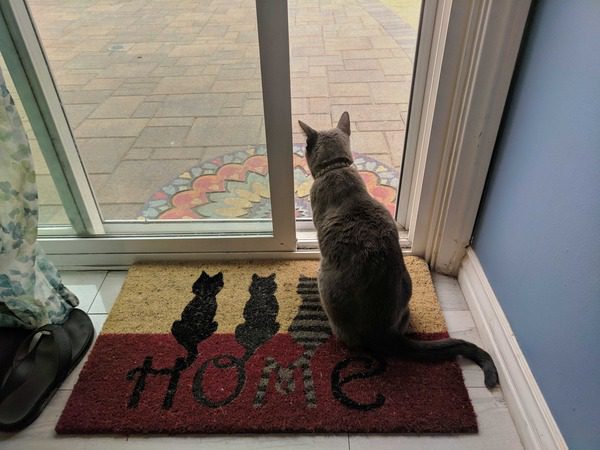
Pet Screens, Let’s Review
What are Pet Screens?
Pets are much-loved members of the family but can sometimes pose a challenge when it comes to the treatment of furniture and anything else in the house. This is especially true in the case of screen doors, which are usually more fragile than a normal door, and household pets can damage them in a number of ways, such as:
– Dogs: Screen doors are a barrier stopping a dog from getting outside, which is made even worse as they can clearly see what’s on the other side, and they want it. Dogs can claw or get their teeth into regular screen doors to try to tear them apart. They can also just straight-up crash into them and knock them out if they’re coming at them in a hurry.
– Cats: Cats, generally, don’t have the strength or desire to pull out a screen door, but they do love scratching their nails and stretching on the grate-like surface of a screen which will tear it open in time and then the curiosity really begins. Cats are also known to climb up screen doors like it’s a tree, which can end up pulling them out of their frame.
For these reasons, special pet-resistant screens are needed, which use different screen material to normal screens to give them extra strength and make them tear-resistant. A pet screen will still provide all the functionality of a normal screen, that is, keeping out bugs and providing a certain amount of privacy while also allowing air to circulate, but it will just be a more heavy-duty version.
What Materials Are Used in a Pet Screen
Pet screen material should be vinyl (PVC) coated polyester or nylon fibers for a few reasons. The first of these is that PVC-coated fibers are up to seven times stronger than regular screen materials, and while they are tight-knit, the fibers also have more give in them than some types of metal-based screens, which may just crack if hit by a sprinting hound who can’t stop in time. As well as adding a protective coating from pet claws, the PVC coating also helps protect the fiber strands from the worst of the sun’s rays, as well as salt, oils, and moisture in general.
The second reason to be careful about the pet screen materials you use is to ensure they aren’t toxic or harmful to your pets. Standard screen materials like carbon fiber and aluminum may not be hugely toxic in the small amounts a pet is likely to ingest (though some dogs can chew through a whole one, which is definitely not a good thing), but these materials don’t digest at all and so can cause gastrointestinal blockages for your pets. The best pet screen material in this sense is polyester fiber which, while not excellent in huge quantities, is just the same as the filling in a pet’s play toy.
It should also be noted that there may be chemicals you want to avoid in some popular screen washes, so be sure to check for a non-toxic version before cleaning your screens.
What Kind of Pet Screens Are There
Depending on the type of pet you have, the challenge will be different for protecting your screen from them. The typical forms of pet screen solutions are:
Pet Resistant Screens
These are normal screens but made with the heavy-duty PVC-coated polyester fiber mentioned earlier. They have extra strength to deal with the vast majority of animal interests, so you can feel safe leaving your pet alone with them without coming home to find one or both to have disappeared. The fiber is thicker, so the screen apertures are also slightly larger to allow for air and light but still too small for bugs to pass through.
Pet Guards
For the toughest pet challenges, mainly very large and active dogs, then a full-on pet guard might be necessary. This is like a barrier for your screen, which protects the screen from being reached and scratched or gnawed by your pet. It functions like a gate, with vertical bars, and can be made from a variety of metals with varying levels of width and number of bars. This will keep your screen safe while still letting it function fully.
Pet Doors
Pet doors, which allow pets to move freely between outside and inside, can also be installed on pet screens. Without any barrier to entry or exit, a lot of the reason for picking on the screen door is gone, and if it’s made of pet screen material, then it will be built to survive most wear and tear. Whether you want to have a pet door included in a screen door, you’re having installed or to install a pet door on an existing screen door, you can ask your Screenmobile technician to help you out.
Pet Screens for Windows
In the same vein as pet screen doors, screens for windows also need protection from pets, especially those behind tall furniture or anything to do with cats. Using the same PVC-coated polyester as the pet screen material, your screen windows should be tough enough to survive most scratching, climbing and pulling. The frames can be an issue, and it’s important to get screen window frames that don’t pop out too easily.
What is the Best Screen for Pets
The pet screen vs. regular screen debate is relatively easy to settle. If you have a pet that’s in any way curious about the outside or your furniture, you should most likely get a pet screen for your doorways and possibly windows, too (in the case of cats or windows beside sofas or other tall furniture). This pet screen will be made of special, heavy-duty material, such as PVC-coated polyester, that is not dangerous or toxic for your pet.
As to whether you should get a pet screen, screen guard or a pet door, well, that will depend on your pet, its size and desire to get outside, whether it’s allowed outside and whether they’re big enough to get through even a pet screen or agile enough to reach a window. Those are all individual decisions, but our Screenmobile technicians are always happy to help you find the best option for your family, pets and all.
To find out more about installing pet screen doors or windows, pet guards or pet doors, you can read more about what Screenmobile offers here or go here to find your local Screenmobile operator.



